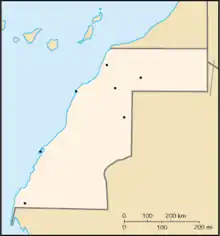| Sahrawi insurgency | |||||||||
|---|---|---|---|---|---|---|---|---|---|
| Part of Western Sahara conflict | |||||||||
 Map of Spanish Sahara | |||||||||
| |||||||||
| Belligerents | |||||||||
|
Polisario Front Support: | |||||||||
| Casualties and losses | |||||||||
| 5,000 killed | |||||||||
The Sahrawi insurgency (1973–1976) was an armed insurgency led by the Polisario Front against Spanish colonial rule in the Spanish Sahara, from 10 May 1973 to 26 February 1976.[1]
Insurgency
The Polisario Front was formally established on 10 May 1973 under the leadership of El-Ouali Mustapha Sayed at Ain Ben Tlili by several young Sahrawis who were principally educated in Morocco and conscious of Third World liberation movements.[2] The Sahrawi People's Liberation Army (SPLA) began an armed rebellion against Spanish rule on the same day, and it gained support from Libya.[1]
The Polisario Front's first attack was conducted on 20 May 1973 against a Spanish military outpost in El-Khanga. It soon carried out more attacks against other smaller military outposts and repeatedly assaulted the phosphate mines of Bou Craa. It damaged the phosphate transport systems linking the mines with the ports. In March 1974, Spain mobilized its military divisions and launched Operation Barrido, in which the Tropas Nómadas, Policía Territorial and military helicopters were used against Polisario militants.[3]
The Polisario Front was determined to gain total independence by mid-1974, and its growing support neutralized the Djema'a and pro-Spanish Sahrawi National Union Party (PUNS). A UN mission that visited Spanish Sahara in May 1975 concluded that the Polisario Front "appeared as a dominant political force."[4]
The Polisario Front's guerrilla tactics severely weakened the resolve of the Spanish to recoup what they could from their investment in the Bou Craa operation. By early 1975, the Polisario Front was active to the point that Spanish troops withdrew from all interior territories apart from Smara, restricting Spanish operations to coastal towns. As a result of the capture of two Spanish patrols by the Polisario Front, including 6 Spanish officers and 14 vehicles, all Spanish dependents were repatriated.[5] The Spanish government began to negotiate prisoner releases and considered plans to hand over authority to the Polisario Front in exchange for long-term fishing and phosphate privileges. This caused King Hassan II of Morocco to mobilize the Green March in November 1975.[4]
In late October 1975, Governor General Federico Gómez dissolved the Tropas Nómadas and Policía Territorial. This prompted roughly a thousand Sahrawi soldiers to collect their weapons and defect to the Polisario Front, which had no more than a couple hundred trained men with arms.[5] Spain withdrew its troops from the Spanish Sahara on 12 January 1976 and formally ended its presence in the territory on 26 February 1976. In total, 5,000 individuals were killed in the conflict. Morocco immediately claimed sovereignty over the territory, which led to the Western Sahara War (1975–1991).[1] On 27 February 1976, the Sahrawi Arab Democratic Republic was proclaimed in Bir Lehlu.[6]
Clashes with the Sahrawi National Union Party
The Sahrawi National Union Party (PUNS) was the only legal party in Spanish Sahara.[7] It was set up by Francoist Spain to rally Sahrawi support. It frequently denounced the revolutionary and nationalist Polisario Front. On July 6, 1975, clashes took place in El Aaiun between the Polisario Front and PUNS, with several wounded. The PUNS offices in Smara were burned by Polisario members on the night before.[8] On 14 November 1975, Secretary General of PUNS, Dueh Sidina Nancha, dissolved the PUNS and gave the members a chance to join the Polisario Front.[9] After the Green March, Nancha stated that "our 20,000 (PUNS) militants integrated the Polisario: in war it is needed to fight united".[10]
References
- 1 2 3 "35. Spanish Sahara (1965-1976)". uca.edu. Retrieved 2023-11-18.
- ↑ Lippert, Anne (April 1992). "Sahrawi Women in the Liberation Struggle of the Sahrawi People". Signs: Journal of Women in Culture and Society. 17 (3): 698. doi:10.1086/494752. ISSN 0097-9740.
- ↑ Besenyő, János (2017). "Guerrilla Operations in Western Sahara: The Polisario versus Morocco and Mauritania". Connections. 16 (3): 23–46. ISSN 1812-1098.
- 1 2 Naylor, Phillip C. (2015-01-15). North Africa, Revised Edition: A History from Antiquity to the Present. University of Texas Press. p. 239. ISBN 978-0-292-76190-2.
- 1 2 Baers, Michael (2022-10-10). A History of the Western Sahara Conflict: The Paper Desert. Cambridge Scholars Publishing. pp. 228–229. ISBN 978-1-5275-8573-7.
- ↑ munadil (2023-02-27). "FEBRUARY 27, 1976: PROCLAMATION OF THE INDEPENDENCE OF THE SAHRAWI ARAB DEMOCRATIC REPUBLIC". POR UN SAHARA LIBRE .org - PUSL. Retrieved 2023-11-18.
- ↑ Algueró Cuervo, José Ignacio (2006). El Sahara y España: claves de una descolonización pendiente (in Spanish). Santa Cruz de Tenerife: Ediciones Idea - Cuadernos del Magreb. pp. 148–149. ISBN 84-96640-31-0.
- ↑ "Primer enfrentamiento entre el PUNS y el POLISARIO" (PDF) (in Spanish). Hoja del Lunes (Cádiz). 1975-07-07. Archived from the original (PDF) on 2016-08-17. Retrieved 2012-12-04.
- ↑ Bárbulo, Tomás (2002). La historia prohibida del Sáhara Español. Barcelona: Ediciones Destino / Colección Imago Mundi vol. 21. pp. 184–185. ISBN 978-84-233-3446-9.
- ↑ "El regreso del PUNS" (in Spanish). El País. 1988-01-02. Retrieved 2012-12-04.